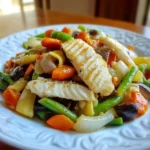I remember the first time I made this Steamed Tilapia with Mixed Vegetables. It was one of those hectic weeknights where time was short, energy was low, but the desire for something genuinely healthy and satisfying was high. I’d picked up some beautiful tilapia fillets and had a crisper drawer full of colourful vegetables begging to be used. Steaming seemed like the quickest, cleanest, and healthiest option. I was slightly apprehensive – would it be bland? Would the kids turn their noses up? To my absolute delight, it was a resounding success. The fish was incredibly moist and flaky, infused with the subtle aromas of ginger and garlic, and the vegetables were perfectly tender-crisp, retaining their vibrant colours and nutrients. Even my pickiest eater commented on how “bright” the dish tasted. Since then, this recipe has become a staple in our home. It’s my go-to for a light yet fulfilling meal that doesn’t require hours in the kitchen or a mountain of washing up. It feels wholesome, looks beautiful on the plate, and delivers fantastic flavour with minimal effort – a true weeknight winner that proves healthy eating can be incredibly delicious and accessible.
Ingredients
- Tilapia Fillets: 2 (around 6-8 oz each), fresh or thawed frozen – The star protein, known for its mild flavour and flaky texture.
- Low-Sodium Soy Sauce: 3 tablespoons – Provides the savoury, umami base for the sauce.
- Sesame Oil: 1 tablespoon – Adds a distinct nutty aroma and richness.
- Rice Vinegar: 1 tablespoon – Offers a gentle tang to balance the flavours.
- Fresh Ginger: 1 tablespoon, minced or finely grated – Adds a warm, zesty kick that complements the fish beautifully.
- Garlic: 2 cloves, minced – Provides a pungent, aromatic depth.
- Broccoli Florets: 1 cup – Adds texture, colour, and valuable nutrients.
- Carrot: 1 medium, julienned or thinly sliced diagonally – Offers sweetness, crunch, and vibrant orange colour.
- Bell Pepper: 1/2 (any colour), thinly sliced – Contributes sweetness and a pop of colour (red, yellow, or orange work well).
- Snow Peas or Sugar Snap Peas: 1/2 cup, trimmed – Provide a delightful crispness and fresh green flavour.
- Scallions (Green Onions): 2, thinly sliced (greens and whites separated) – Used both in the steaming liquid/sauce and as a fresh garnish.
- Optional: Maple Syrup or Honey: 1 teaspoon – For a touch of sweetness to balance the savoury notes, adjust to taste.
- Optional: Red Pepper Flakes: Pinch – For those who enjoy a subtle hint of heat.
- Optional Garnish: Toasted Sesame Seeds: 1 teaspoon – Adds texture and enhances the nutty flavour.
- Optional Garnish: Fresh Cilantro Leaves: Small handful – Provides a fresh, herbaceous finish.
- Water or Vegetable Broth: 1/2 cup (for the steamer) – Creates the steam needed for cooking.
Instructions
- Prepare the Sauce: In a small bowl, whisk together the low-sodium soy sauce, sesame oil, rice vinegar, minced ginger, minced garlic, and the white parts of the sliced scallions. If using, stir in the optional maple syrup/honey and red pepper flakes. Set aside.
- Prepare the Fish: Pat the tilapia fillets completely dry with paper towels. This helps the sauce adhere better and prevents excess wateriness. You can lightly score the top of the thicker part of the fillets (making shallow diagonal cuts) to help them cook more evenly and absorb the sauce, but this is optional. Place the fillets in a shallow dish or on a heatproof plate that will fit comfortably inside your steamer basket, leaving some room around the edges for steam circulation.
- Season the Fish: Pour about half of the prepared sauce evenly over the tilapia fillets, ensuring they are well-coated.
- Prepare the Steamer: Set up your steamer. If using a bamboo steamer over a wok or pot, add about an inch of water to the wok/pot, ensuring the water level is below the bottom of the steamer basket. If using a pot with a steamer insert, add water to just below the level of the insert. Bring the water to a gentle simmer over medium heat. You can add a few slices of ginger or the tougher green parts of the scallions to the water for extra aroma, if desired.
- Arrange Vegetables: Scatter the prepared vegetables (broccoli florets, carrots, bell pepper, snow peas/sugar snap peas) around the tilapia fillets on the plate or in the steamer basket layer(s). Try not to overcrowd the steamer; if necessary, use a multi-layered steamer or steam in batches. Distribute them evenly for consistent cooking.
- Steam the Fish and Vegetables: Carefully place the plate with the fish and vegetables into the steamer basket, or arrange the fish/vegetables directly in the basket(s). Cover the steamer tightly with its lid.
- Cooking Time: Steam for approximately 10-15 minutes. The exact time will depend on the thickness of the tilapia fillets and the size of your vegetable pieces. The fish is cooked when it is opaque throughout and flakes easily with a fork. The vegetables should be tender-crisp – cooked through but still retaining some bite and vibrant colour. Avoid overcooking, as the fish can become dry and the vegetables mushy.
- Check for Doneness: Carefully lift the lid (away from your face to avoid steam burns) around the 10-minute mark to check. Insert a fork into the thickest part of a fillet; if it flakes easily, it’s done. If not, replace the lid and steam for a few more minutes.
- Final Touches: Once cooked, carefully remove the plate or steamer basket from the pot. Drizzle the remaining sauce over the fish and vegetables.
- Garnish and Serve: Garnish generously with the green parts of the sliced scallions and, if using, toasted sesame seeds and fresh cilantro leaves. Serve immediately.
Nutrition Facts
- Servings: 2
- Calories Per Serving: Approximately 300-350 kcal (This is an estimate and can vary based on fillet size and exact vegetable quantities).
- Lean Protein Powerhouse: Tilapia provides a significant amount of high-quality, lean protein (around 30-40g per serving), crucial for muscle maintenance, satiety, and overall body function.
- Low in Saturated Fat: This dish is naturally low in unhealthy saturated fats, making it a heart-healthy choice compared to many fried or heavily sauced protein options.
- Rich in Vitamins & Minerals: The colourful array of mixed vegetables contributes essential vitamins (like Vitamin C from bell peppers, Vitamin A from carrots) and minerals vital for immune function and overall well-being.
- Source of Omega-3 (Moderate): While not as high as fatty fish like salmon, tilapia does contain some Omega-3 fatty acids, which are beneficial for heart and brain health.
- Dietary Fiber: The vegetables provide dietary fibre, aiding digestion and contributing to feelings of fullness.
Preparation Time
- Total Time: Approximately 25-30 minutes. This includes about 10-15 minutes for prepping the ingredients (washing and chopping vegetables, mixing the sauce, preparing the fish) and 10-15 minutes of active steaming time. It’s a genuinely quick meal perfect for busy schedules.
How to Serve
This Steamed Tilapia with Mixed Vegetables is wonderfully versatile. Here are some serving suggestions:
- Classic & Simple:
- Serve hot, directly from the steamer, over a bed of fluffy steamed white or brown rice. The rice soaks up the delicious sauce beautifully.
- Lower Carb Option:
- Pair with quinoa for a higher protein and fibre grain alternative.
- Serve alongside cauliflower rice for a very low-carbohydrate meal.
- Noodle Bowl Style:
- Serve over cooked soba noodles or rice noodles, tossing gently to coat the noodles with the sauce.
- Enhanced Presentation:
- Carefully plate individual servings, arranging the colourful vegetables attractively around the tilapia fillet.
- Drizzle extra sauce just before serving.
- Ensure garnishes (scallions, sesame seeds, cilantro) are fresh and vibrant.
- Family Style:
- Place the entire steaming plate (if presentable and heatproof) or transfer the contents carefully to a larger platter for everyone to serve themselves at the table.
Additional Tips
- Choose the Right Fish: While the recipe specifies tilapia, other mild white fish fillets work beautifully too! Try cod, halibut, snapper, flounder, or basa fillets. Adjust steaming time based on fillet thickness.
- Don’t Overcrowd the Steamer: Ensure steam can circulate freely around the fish and vegetables for even cooking. If your steamer is small, steam the fish first for a few minutes, then add the quicker-cooking vegetables, or use a multi-tiered steamer.
- Vegetable Variations: Feel free to swap or add vegetables based on preference or what’s in season. Asparagus spears, bok choy, sliced mushrooms (shiitake are great!), zucchini ribbons, or green beans are all excellent choices. Remember to cut denser vegetables smaller or add them earlier.
- Boost the Aromatics: Add a few thin slices of lemon or lime on top of the fish before steaming for a bright, citrusy note. A small knob of lemongrass, lightly bruised, added to the steaming water also imparts a lovely fragrance.
- Sauce Customization: Adjust the sauce to your taste. Like it spicier? Add more red pepper flakes or a dash of sriracha. Prefer it tangier? Add a bit more rice vinegar. Want it richer? A tiny drop more sesame oil goes a long way.
- Ensure Fish is Thawed: If using frozen tilapia fillets, make sure they are completely thawed before cooking. Place them in the refrigerator overnight or use the defrost setting on your microwave (being careful not to start cooking them). Pat them extra dry after thawing.
- Check Doneness Accurately: The “flakes easily with a fork” test is reliable. The flesh should transition from translucent to opaque. An instant-read thermometer inserted into the thickest part should register 145°F (63°C). Overcooked fish becomes dry and tough.
- Make-Ahead Sauce: The sauce (soy sauce, sesame oil, vinegar, ginger, garlic mixture) can be whisked together and stored in an airtight container in the refrigerator for 2-3 days. This saves a step during busy weeknight cooking.
FAQ Section
- Q: Can I use frozen tilapia fillets for this recipe?
- A: Yes, absolutely! Just ensure the fillets are fully thawed before you begin. Thaw them safely in the refrigerator overnight for best results. Pat them very dry with paper towels after thawing to remove excess moisture, which can dilute the sauce and affect steaming.
- Q: What other vegetables work well in this steamed dish?
- A: Many vegetables are suitable for steaming! Consider adding bok choy (separate leaves and stems, add stems earlier), asparagus spears, green beans, sliced zucchini or summer squash, mushrooms (shiitake, cremini), or even edamame pods. Adjust steaming time based on the vegetable’s density.
- Q: My fish always seems bland when steamed. How can I add more flavour?
- A: Don’t skip seasoning the fish directly with the sauce before steaming! Also, ensure your aromatics (ginger, garlic) are fresh and finely minced for maximum flavour release. Adding aromatics like ginger slices or lemongrass to the steaming water helps infuse flavour. Finally, be generous with the final drizzle of sauce and fresh garnishes like scallions and cilantro. Marinating the fish in the sauce for 15-20 minutes before steaming can also deepen the flavour.
- Q: Is Steamed Tilapia a healthy dinner option?
- A: Yes, it’s generally considered a very healthy choice. Tilapia is a lean source of protein, low in saturated fat. Steaming is a healthy cooking method that doesn’t require added fats like frying or sautéing. Paired with nutrient-rich vegetables, it creates a balanced, low-calorie, and wholesome meal. (Note: Be mindful of sourcing regarding tilapia; opt for responsibly farmed options when possible).
- Q: How do I know when the tilapia is perfectly cooked and not overdone?
- A: The best way is to check the thickest part of the fillet. It should look opaque all the way through (no longer translucent) and flake easily when gently pressed with a fork. If you have an instant-read thermometer, the internal temperature should reach 145°F (63°C). Start checking a minute or two before the minimum recommended cooking time, as fillet thickness varies.
- Q: Can I prepare parts of this dish ahead of time?
- A: Yes! You can chop the vegetables and store them in an airtight container in the fridge for a day or two. The sauce can also be mixed ahead and refrigerated for 2-3 days. This makes assembly and steaming much quicker on the day you plan to eat it. However, it’s best to steam the fish and vegetables just before serving for optimal texture and freshness.
- Q: What can I serve with Steamed Tilapia besides rice?
- A: Quinoa is a great higher-protein grain alternative. For low-carb options, serve it with cauliflower rice, zucchini noodles (zoodles), or a simple side salad. Steamed or roasted potatoes can also work, although rice or quinoa complements the Asian-inspired flavours particularly well. Light noodle options like soba or glass noodles are also delicious.
- Q: How can I make this recipe gluten-free?
- A: It’s very easy to make this gluten-free! The main ingredient to watch is the soy sauce. Simply substitute the regular soy sauce with a gluten-free tamari or a certified gluten-free soy sauce alternative like coconut aminos. All other typical ingredients in this recipe are naturally gluten-free, but always double-check labels if you have severe sensitivities.

Steamed Tilapia with Mixed Vegetables
Ingredients
- Tilapia Fillets: 2 (around 6-8 oz each), fresh or thawed frozen – The star protein, known for its mild flavour and flaky texture.
- Low-Sodium Soy Sauce: 3 tablespoons – Provides the savoury, umami base for the sauce.
- Sesame Oil: 1 tablespoon – Adds a distinct nutty aroma and richness.
- Rice Vinegar: 1 tablespoon – Offers a gentle tang to balance the flavours.
- Fresh Ginger: 1 tablespoon, minced or finely grated – Adds a warm, zesty kick that complements the fish beautifully.
- Garlic: 2 cloves, minced – Provides a pungent, aromatic depth.
- Broccoli Florets: 1 cup – Adds texture, colour, and valuable nutrients.
- Carrot: 1 medium, julienned or thinly sliced diagonally – Offers sweetness, crunch, and vibrant orange colour.
- Bell Pepper: 1/2 (any colour), thinly sliced – Contributes sweetness and a pop of colour (red, yellow, or orange work well).
- Snow Peas or Sugar Snap Peas: 1/2 cup, trimmed – Provide a delightful crispness and fresh green flavour.
- Scallions (Green Onions): 2, thinly sliced (greens and whites separated) – Used both in the steaming liquid/sauce and as a fresh garnish.
- Optional: Maple Syrup or Honey: 1 teaspoon – For a touch of sweetness to balance the savoury notes, adjust to taste.
- Optional: Red Pepper Flakes: Pinch – For those who enjoy a subtle hint of heat.
- Optional Garnish: Toasted Sesame Seeds: 1 teaspoon – Adds texture and enhances the nutty flavour.
- Optional Garnish: Fresh Cilantro Leaves: Small handful – Provides a fresh, herbaceous finish.
- Water or Vegetable Broth: 1/2 cup (for the steamer) – Creates the steam needed for cooking.
Instructions
- Prepare the Sauce: In a small bowl, whisk together the low-sodium soy sauce, sesame oil, rice vinegar, minced ginger, minced garlic, and the white parts of the sliced scallions. If using, stir in the optional maple syrup/honey and red pepper flakes. Set aside.
- Prepare the Fish: Pat the tilapia fillets completely dry with paper towels. This helps the sauce adhere better and prevents excess wateriness. You can lightly score the top of the thicker part of the fillets (making shallow diagonal cuts) to help them cook more evenly and absorb the sauce, but this is optional. Place the fillets in a shallow dish or on a heatproof plate that will fit comfortably inside your steamer basket, leaving some room around the edges for steam circulation.
- Season the Fish: Pour about half of the prepared sauce evenly over the tilapia fillets, ensuring they are well-coated.
- Prepare the Steamer: Set up your steamer. If using a bamboo steamer over a wok or pot, add about an inch of water to the wok/pot, ensuring the water level is below the bottom of the steamer basket. If using a pot with a steamer insert, add water to just below the level of the insert. Bring the water to a gentle simmer over medium heat. You can add a few slices of ginger or the tougher green parts of the scallions to the water for extra aroma, if desired.
- Arrange Vegetables: Scatter the prepared vegetables (broccoli florets, carrots, bell pepper, snow peas/sugar snap peas) around the tilapia fillets on the plate or in the steamer basket layer(s). Try not to overcrowd the steamer; if necessary, use a multi-layered steamer or steam in batches. Distribute them evenly for consistent cooking.
- Steam the Fish and Vegetables: Carefully place the plate with the fish and vegetables into the steamer basket, or arrange the fish/vegetables directly in the basket(s). Cover the steamer tightly with its lid.
- Cooking Time: Steam for approximately 10-15 minutes. The exact time will depend on the thickness of the tilapia fillets and the size of your vegetable pieces. The fish is cooked when it is opaque throughout and flakes easily with a fork. The vegetables should be tender-crisp – cooked through but still retaining some bite and vibrant colour. Avoid overcooking, as the fish can become dry and the vegetables mushy.
- Check for Doneness: Carefully lift the lid (away from your face to avoid steam burns) around the 10-minute mark to check. Insert a fork into the thickest part of a fillet; if it flakes easily, it’s done. If not, replace the lid and steam for a few more minutes.
- Final Touches: Once cooked, carefully remove the plate or steamer basket from the pot. Drizzle the remaining sauce over the fish and vegetables.
- Garnish and Serve: Garnish generously with the green parts of the sliced scallions and, if using, toasted sesame seeds and fresh cilantro leaves. Serve immediately.
Nutrition
- Serving Size: one normal portion
- Calories: 350
- Protein: 40g






